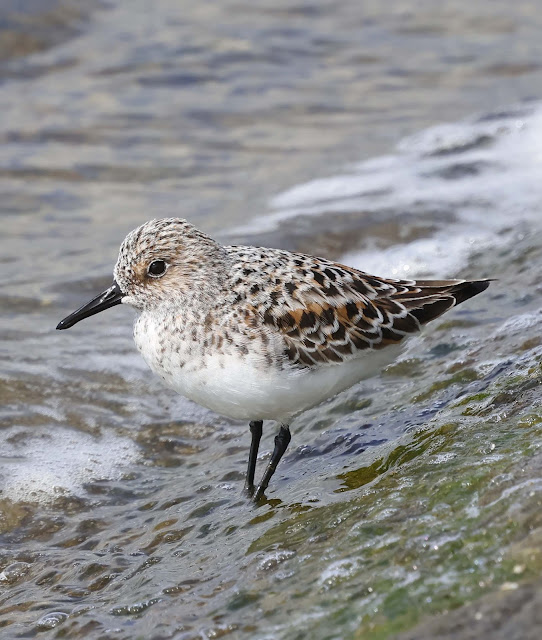The opportunity to see them in breeding plumage at my local Farmoor Reservoir is limited to just a few weeks at the end of May and beginning of June .This year has been a good one for Sanderling passage with a steady stream of birds passing through and spending a day by the causeway before heading north.
Here below are some images of Sanderlings, all taken at Farmoor Reservoir. Note the variety of plumage with some heavily coloured and strongly marked whilst others are at the other extreme, more white and grey than chestnut with minimal strong markings. Others come in all colour grades between and not one bird is the same as another.
 |
| A pale Sanderling with little chestnut colouring or strong patterning and possibly less than a year old |
 |
| An exceptionally strongly coloured and patterned Sanderling that is probably at least two years old |
 |
| A group of Sanderlings and one Dunlin showing the variations in the Sanderlings plumage |
By photographing birds on an almost daily basis and comparing the plumage of each individual it is apparent that birds are passing through daily and rarely remain for longer than a day.
Sanderlings breed right across the Arctic from Canada to Siberia but European birds mainly breed in Greenland and Siberia and winter on the coasts of southern Europe and Africa, sometimes as far as South Africa.
Confirmation of Greenland being the ultimate destination for some came a few years ago in May 2021 when a Sanderling with coloured rings on its legs spent a day beside the causeway.
The colours and combination of the rings enabled it to be identified as having been ringed as a chick in Greenland in July 2020. The fact it arrived at Farmoor would make sense as it would be crossing middle England and heading northwest perhaps towards Iceland where it might stop before flying to northeast Greenland, its place of birth. It would be equally fascinating to know where it had come from - the southern or eastern coast of England or maybe much further south?
Sanderlings live on average for seven years although there is a record of one almost eighteen years old. For a bird that undertakes a round trip migration of from 6000- 20,000 miles annually this is remarkable considering all the dangers and hazards it faces.
I have always wondered why there is such individual variation in the plumage of the Sanderlings that stop off at the reservoir on their northward migration. One suggestion is that birds commencing their moult to summer plumage as they leave their winter homes arrest that moult while they migrate before completing the transition to full breeding plumage.on their breeding areas
Another theory is that as they do not breed until two years old, the paler birds that arrive at the reservoir each Spring are only in their second calendar year i.e. less than a year old and therefore unlikely to breed and consequently less likely to adopt full breeding colours until the year after. This would agree with my suspicion that the more colourful the plumage is, the older the individual. .
I should say I am happy to be corrected on the above if anyone has an alternative suggestion.















No comments:
Post a Comment